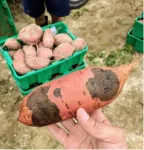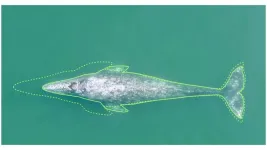(Press-News.org) Reno, Nev. (June 12, 2024) – The Western U.S. is heavily reliant on mountain snowpacks and their gradual melt for water storage and supply, and climate change is expected to upend the reliability of this natural process. Many agricultural communities in this part of the country are examining ways to adapt to a future with less water, and new research shows that a focus on supplementing water supply by expanding reservoir capacity won’t be enough to avert future water crises.
Led by scientists at the Desert Research Institute (DRI), the study published June 11 in Earth’s Future. By identifying agricultural communities considered at-risk from looming changes in snowfall and snowmelt patterns, the researchers found that water conservation measures like changes in crop type and extent were more stable adaptive strategies than changes to reservoir capacity. By the end of the century, many areas could have less than half the water they have historically relied on to refill their reservoirs, but changing the types and extent of their crops could help by restoring an average of about 20% of reservoir capacity.
The research team included scientists with the diversity of expertise needed to capture the complexities of water systems while balancing concerns for locally focused adaptation. Beatrice Gordon, lead author of the study and sociohydrologist and postdoctoral researcher at DRI, says the research is needed to inform water management at the local level, where most decisions are made. Gordon herself grew up on a ranch in Wyoming, where she learned firsthand the challenges that face water-insecure communities – an experience that helped lead to her research focus on agriculture and water in the Western U.S.
“A lot of decisions about water are made at the local level, but there’s this big disconnect between that reality and the macro-scale level of most research on this topic,” Gordon says. “We really wanted to understand what the future could look like at the scale that most communities manage their water resources. What are the levers that folks in these communities have when it comes to a future with less snow?”
Mountain snowpacks have historically acted as nature’s water towers across much of the region by storing winter precipitation and releasing it downstream during drier months. Water management systems were designed with this process in mind, but climate change is altering snowmelt patterns in ways that will make it difficult for existing systems to meet the needs of downstream water users. As the world’s largest user of freshwater, irrigated agriculture is at particularly high risk from these changes.
Strategies for addressing water shortages that focus on augmenting supply include expanding reservoirs and replenishing groundwater with surplus water, but these approaches become less effective as the timing and availability of precipitation become more unpredictable. In contrast, water conservation strategies such as reducing total crop acreage, periodic crop fallowing, and shifting toward higher value crops can help manage these risks.
To find out how risk management practices could work on a community-level scale, the researchers built a comprehensive risk assessment framework based on guidance from the Intergovernmental Panel on Climate Change (IPCC). For each of 13 communities, they gathered historical data on irrigation water supply, agricultural water demand, snow storage and snowmelt patterns, and more. They then used projections for the future climate through 2100 to understand how supply and demand dynamics may change in the near future.
“We gathered all these data together and looked at the picture of risk, and then also the ways that adaptation could reduce risk,” Gordon says. “Our goal was really to make this as relevant as possible for the people who are actually making decisions on the ground.”
“Dr. Gordon assembled a very impressive and unprecedented dataset for this paper linking agricultural water supply and demand across the Western United States,” says study co-author Gabrielle Boisramé, assistant research professor at DRI.
The Western agricultural communities the researchers selected are located in headwaters areas, making them both subject to significant changes in future climate and sentinels for the future of the West. Several of them are located in the Upper Colorado River Basin, which feeds into the main stem of the river – a water system that supports more than 40 million people.
“A lot of these areas are providing downstream water to other communities,” Gordon says. “So, if they have an increase in demand and a decrease in supply, it impacts not only that area, but also the areas that rely on that water downstream.”
The study results show that there will be a stark decline in how much many of these communities will be able to refill their reservoirs in just a few decades, with some seeing declines to about half of the water they were historically able to store. A drop that significant is particularly acute in many of the smaller reservoirs that can only hold about a year’s worth of water.
“It shows how important it is to dedicate effort – now, not in 20 to 50 years -- to figuring out how we, as scientists, can provide better information about water conservation,” Gordon says. “And I think that there's an opportunity to really think about how we support communities in these efforts, especially small communities in headwaters regions that might be fully dependent on agriculture.”
“Our results indicate the importance of water conservation as an adaptive strategy in a warmer future with less snow,” she continues. “And that's broadly true across a lot of different places in the Western U.S.”
– @driscience –
More information: The full study, The Essential Role of Local Context in Shaping Risk and Risk Reduction Strategies for Snowmelt-Dependent Irrigated Agriculture, is available from Earth’s Future at https://agupubs.onlinelibrary.wiley.com/doi/10.1029/2024EF004577
Study authors include: Beatrice Gordon (DRI, UNR), Gabrielle Boisramé (DRI), Rosemary Carroll (DRI), Newsha Ajami (LBNL), Bryan Leonard (UWYO), Christine Albano (DRI), Naoki Mizukami (NCAR), Manuel Andrade (UNR), Elizabeth Koebele (UNR), Michael Taylor (UNR), and Adrian Harpold (UNR)
About DRI
We are Nevada’s non-profit research institute, founded in 1959 to empower experts to focus on science that matters. We work with communities across the state — and the world — to address their most pressing scientific questions. We’re proud that our scientists continuously produce solutions that better human and environmental health.
Scientists at DRI are encouraged to follow their research interests across the traditional boundaries of scientific fields, collaborating across DRI and with scientists worldwide. All faculty support their own research through grants, bringing in nearly $5 to the Nevada economy for every $1 of state funds received. With more than 600 scientists, engineers, students, and staff across our Reno and Las Vegas campuses, we conducted more than $47 million in sponsored research focused on improving peoples’ lives in 2023 alone.
At DRI, science isn’t merely academic — it’s the key to future-proofing our communities and building a better world. For more information, please visit www.dri.edu.
Media Contact
Elyse DeFranco
Science Writer, DRI
Elyse.defranco@dri.edu
END
Western agricultural communities need water conservation strategies to adapt to future shortages
Relying on water storage won’t be enough to make up for declines in future water availability under a changing climate, new study shows
2024-06-12
ELSE PRESS RELEASES FROM THIS DATE:
Does having a child with low birth weight increase a person’s risk of dementia?
2024-06-12
EMBARGOED FOR RELEASE UNTIL 4 P.M. ET, WEDNESDAY, JUNE 12, 2024
MINNEAPOLIS – People who give birth to infants less than 5.5 pounds may be more likely to have memory and thinking problems later in life than people who give birth to infants who do not have a low birth weight, according to a study published in the June 12, 2024, online issue of Neurology®, the medical journal of the American Academy of Neurology. The effect on memory and thinking skills was equivalent to one to two years of aging for those with low-birth-weight deliveries.
The study does not prove that delivery of a low-birth-weight ...
Depressive symptoms in young adults linked to thinking, memory problems in midlife
2024-06-12
EMBARGOED FOR RELEASE UNTIL 4 P.M. ET, WEDNESDAY, JUNE 12, 2024
MINNEAPOLIS – People who experience prolonged depressive symptoms starting in young adulthood may have worse thinking and memory skills in middle age, according to a study published in the June 12, 2024, online issue of Neurology®, the medical journal of the American Academy of Neurology. The study also found that depressive symptoms were experienced more often by Black adults than white adults.
“The processes that lead to dementia begin long before signs of the disease become apparent, and previous research has shown that Black adults have a higher risk of dementia than white adults,” said study author ...
Avoidable deaths during Covid-19 associated with chronic hospital nurse understaffing
2024-06-12
Philadelphia (June 12, 2024) – A new study published in International Journal of Nursing Studies showed that individuals with Covid-19 were more likely to die in hospitals that were chronically understaffed before the pandemic. This study is one of the first to document the continuing public health dangers of permitting so many U.S. hospitals to ration nursing care by understaffing nursing services.
The study, conducted by researchers at the Center for Health Outcomes and Policy Research (CHOPR) at the University ...
Convenient at-home test identifies at-risk individuals with inadequate immunity to COVID-19
2024-06-12
By late in the pandemic more than 96% of individuals in the U.S. ages 16 and older had COVID-19 antibodies from infection or vaccination. However, immunity from the virus tends to wane over time. Uptake of the boosters has been quite low, meaning that over time the current high levels of protection will dissipate.
During the COVID-19 pandemic, at-home antigen tests became widely accepted for detecting infection. In a new joint study by the George Washington University, the University of North Carolina, and others, researchers looked into the benefits of using at-home antibody tests to detect immunity and to make decisions about the need for a COVID-19 booster shot - something ...
Sweetpotato’s sweet revenge
2024-06-12
Sweetpotato black rot is a devastating disease caused by the fungus Ceratocystis fimbriata. Since the late 1800s, black rot of sweetpotato has threatened to destroy as much as 30% of the sweetpotato crop in the United States. In 2015, all sweetpotato-producing states in the United States experienced one of the worst outbreaks recorded in history, with up to 60% losses reported. While fungicides can help manage the disease, they are not a sustainable solution, especially with volatile restrictions on fungicide residues among major export markets. An additional ...
Pacific coast gray whales have gotten 13% shorter in the past 20-30 years, Oregon State study finds
2024-06-12
Gray whales that spend their summers feeding in the shallow waters off the Pacific Northwest coast have undergone a significant decline in body length since around the year 2000, a new Oregon State University study found.
The smaller size could have major consequences for the health and reproductive success of the affected whales, and also raises alarm bells about the state of the food web in which they coexist, researchers say.
“This could be an early warning sign that the abundance of this population is starting to decline, or is not healthy,” said K.C. Bierlich, co-author on the study and an assistant professor at OSU’s ...
Pairing shelter dogs has ‘pawsitive’ results
2024-06-12
Shelter dogs awaiting adoption fare better with a canine companion than when they’re housed alone, according to new research from Virginia Tech.
The study, led by Erica Feuerbacher, associate professor in the College of Agriculture and Life Sciences’ School of Animal Sciences, revealed that companiable dogs housed together showed fewer signs of stress and were adopted more quickly than dogs that were housed by themselves.
Nearly 4 million dogs enter shelters every year, according to the American Society for the Prevention of Cruelty to Animals. The study’s findings offer one possible solution for animal shelters ...
Ancient Syrian diets resembled the modern “Mediterranean diet”
2024-06-12
Thousands of years ago, people in ancient Syria likely ate mostly grains, grapes, olives and a small amount of dairy and meat — similar to today’s “Mediterranean diet,” according to a study published June 12 in the open-access journal PLOS ONE by Benjamin T. Fuller from the University of Leuven, Belgium, Simone Riehl from the University of Tübingen, Germany, and colleagues.
Tell Tweini, an archeological site located near the Syrian coastal city of Jableh, contains relics dating ...
Greek Island was home to Bronze Age purple dye workshop
2024-06-12
The Greek island of Aegina was home to a Late Bronze Age purple dye workshop, according to a study published June 12, 2024 in the open-access journal PLOS ONE by Lydia Berger of Paris Lodron University of Salzburg, Austria and colleagues.
Colored dyes were a significant commodity in the Mediterranean region during the Late Bronze Age, and understanding the production of these dyes is valuable for interpretations of culture and trade at the time. In this study, Berger and colleagues describe the site of a purple dye workshop from the 16th century BC located at Aegina Kolonna in the Saronic Gulf.
The presence of a dye workshop at this site is inferred from three main lines of ...
Housing compatible shelter dogs together could reduce stress and might help them find homes sooner
2024-06-12
Housing compatible shelter dogs together could reduce stress and might help them find homes sooner
###
Article URL: https://journals.plos.org/plosone/article?id=10.1371/journal.pone.0301137
Article Title: Effects of single- or pair-housing on the welfare of shelter dogs: Behavioral and physiological indicators
Author Countries: USA
Funding: The current research was funded by a grant to ENF from the Waltham Foundation (grant number) www.waltham.com. The funders had no role in study design, data collection and analysis, decision to ...
LAST 30 PRESS RELEASES:
What causes some people’s gut microbes to produce high alcohol levels?
Global study reveals widespread burning of plastic for heating and cooking
MIT study shows pills that communicate from the stomach could improve medication adherence
Searching for the centromere: diversity in pathways key for cell division
Behind nature’s blueprints
Researchers search for why some people’s gut microbes produce high alcohol levels
Researchers find promising new way to boost the immune response to cancer
Coffee as a staining agent substitute in electron microscopy
Revealing the diversity of olfactory receptors in hagfish and its implications for early vertebrate evolution
Development of an ultrasonic sensor capable of cuffless, non-invasive blood pressure measurement
Longer treatment with medications for opioid use disorder is associated with greater probability of survival
Strategy over morality can help conservation campaigns reduce ivory demand, research shows
Rising temperatures reshape microbial carbon cycling during animal carcass decomposition in water
Achieving ultra-low-power explosive jumps via locust bio-hybrid muscle actuators
Plant-derived phenolic acids revive the power of tetracycline against drug-resistant bacteria
Cooperation: A costly affair in bacterial social behaviour?
Viruses in wastewater: Silent drivers of pollution removal and antibiotic resistance
Sub-iethal water disinfection may accelerate the spread of antibiotic resistance
Three in four new Australian moms struggle with body image
Post-stroke injection protects the brain in preclinical study
Cardiovascular risk score predicts multiple eye diseases
Health: estimated one in ten British adults used or interested in GLP-1 medications for weight loss
Exercise to treat depression yields similar results to therapy
Whooping cough vaccination for pregnant women strengthens babies’ immune system
Dramatic decline in new cases of orphanhood in Uganda driven by HIV treatment and prevention programs
Stopping weight loss drugs linked to weight regain and reversal of heart health markers
Higher intake of food preservatives linked to increased cancer risk
Mass General Brigham–developed cholera vaccine completes phase 1 trial
First experimental validation of a “150-year-old chemical common sense” direct visualization of the molecular structural changes in the ultrafast anthracene [4+4] photocycloaddition reaction
Lack of support for people on weight loss drugs leaves them vulnerable to nutritional deficiencies, say experts
[Press-News.org] Western agricultural communities need water conservation strategies to adapt to future shortagesRelying on water storage won’t be enough to make up for declines in future water availability under a changing climate, new study shows






